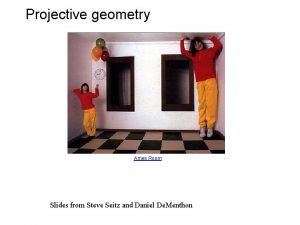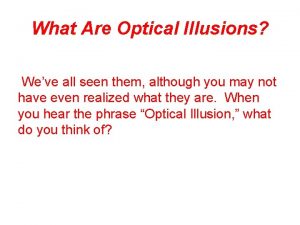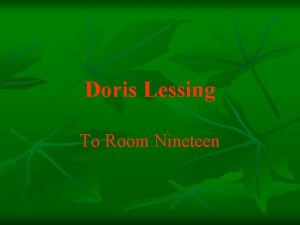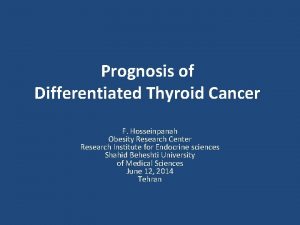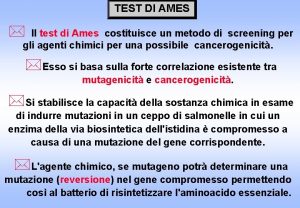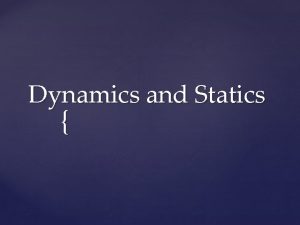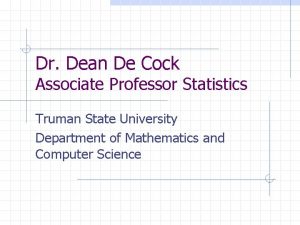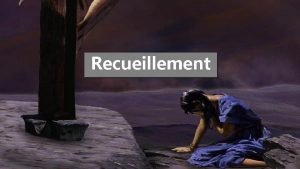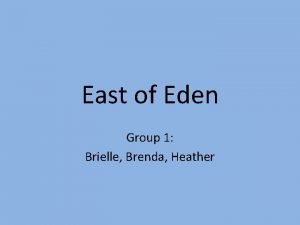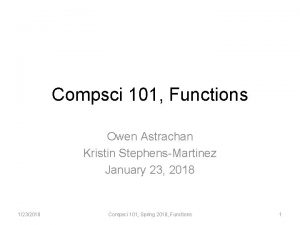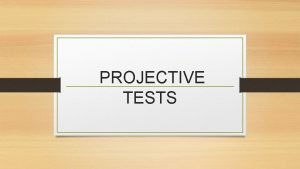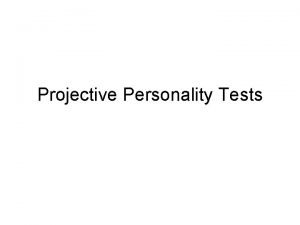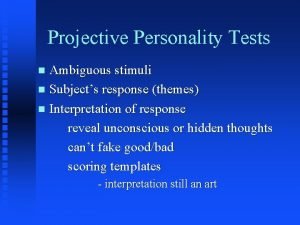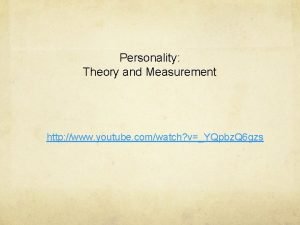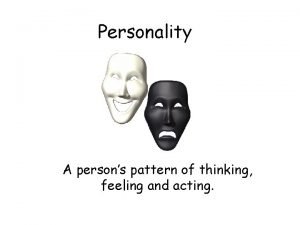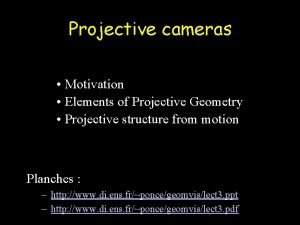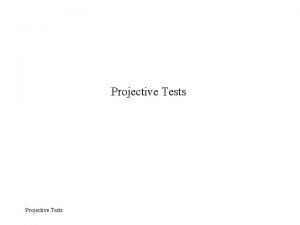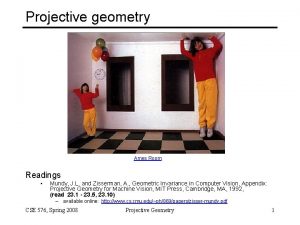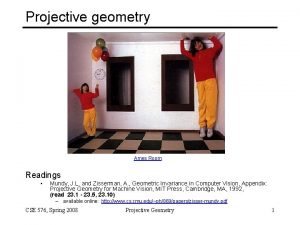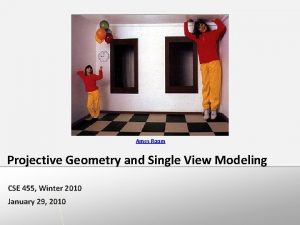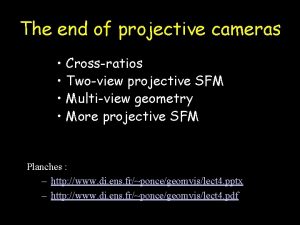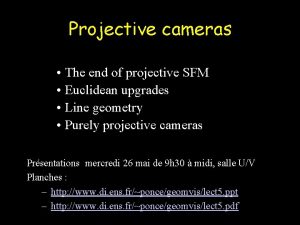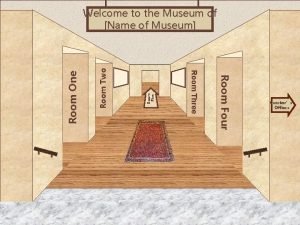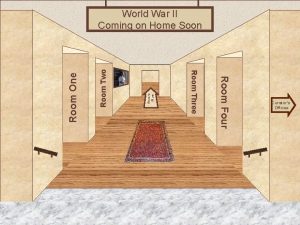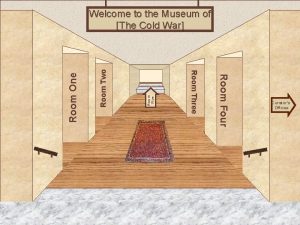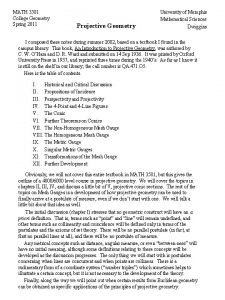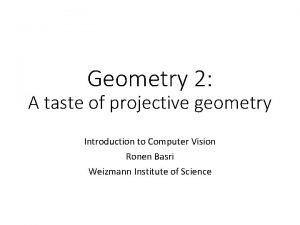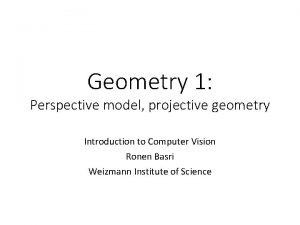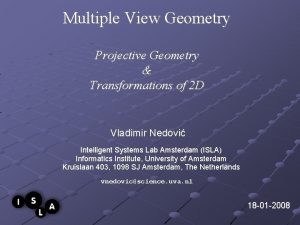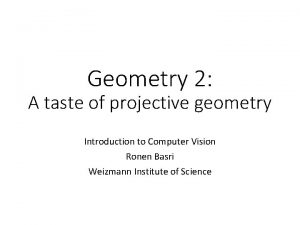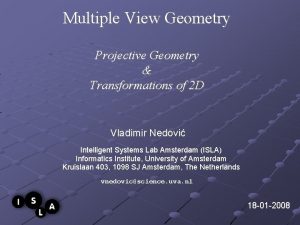Announcements Project 2 questions Projective geometry Ames Room















































- Slides: 47

Announcements • Project 2 questions

Projective geometry Ames Room Readings • Mundy, J. L. and Zisserman, A. , Geometric Invariance in Computer Vision, Appendix: Projective Geometry for Machine Vision, MIT Press, Cambridge, MA, 1992, (read 23. 1 - 23. 5, 23. 10) – available online: http: //www. cs. cmu. edu/~ph/869/papers/zisser-mundy. pdf

Projective geometry—what’s it good for? Uses of projective geometry • • Drawing Measurements Mathematics for projection Undistorting images Focus of expansion Camera pose estimation, match move Object recognition

Applications of projective geometry Vermeer’s Music Lesson Reconstructions by Criminisi et al.

Measurements on planes 4 3 2 1 1 2 Approach: unwarp then measure What kind of warp is this? 3 4

Image rectification p’ p To unwarp (rectify) an image • solve for homography H given p and p’ • solve equations of the form: wp’ = Hp – linear in unknowns: w and coefficients of H – H is defined up to an arbitrary scale factor – how many points are necessary to solve for H? work out on board

Solving for homographies

Solving for homographies A 2 n × 9 h 9 0 2 n Defines a least squares problem: • Since h is only defined up to scale, solve for unit vector ĥ • Solution: ĥ = eigenvector of ATA with smallest eigenvalue • Works with 4 or more points

The projective plane Why do we need homogeneous coordinates? • represent points at infinity, homographies, perspective projection, multi-view relationships What is the geometric intuition? • a point in the image is a ray in projective space -y (x, y, 1) (0, 0, 0) -z x (sx, sy, s) image plane • Each point (x, y) on the plane is represented by a ray (sx, sy, s) – all points on the ray are equivalent: (x, y, 1) (sx, sy, s)

Projective lines What does a line in the image correspond to in projective space? • A line is a plane of rays through origin – all rays (x, y, z) satisfying: ax + by + cz = 0 l p • A line is also represented as a homogeneous 3 -vector l

Point and line duality • A line l is a homogeneous 3 -vector • It is to every point (ray) p on the line: l p=0 l p 1 p 2 l 1 p l 2 What is the line l spanned by rays p 1 and p 2 ? • l is to p 1 and p 2 l = p 1 p 2 • l is the plane normal What is the intersection of two lines l 1 and l 2 ? • p is to l 1 and l 2 p = l 1 l 2 Points and lines are dual in projective space • given any formula, can switch the meanings of points and lines to get another formula

Ideal points and lines -y -z (a, b, 0) -y (sx, sy, 0) x image plane -z x image plane Ideal point (“point at infinity”) • p (x, y, 0) – parallel to image plane • It has infinite image coordinates Ideal line • l (a, b, 0) – parallel to image plane • Corresponds to a line in the image (finite coordinates) – goes through image origin (principle point)

Homographies of points and lines Computed by 3 x 3 matrix multiplication • To transform a point: p’ = Hp • To transform a line: lp=0 l’p’=0 – 0 = lp = l. H-1 Hp = l. H-1 p’ l’ = l. H-1 – lines are transformed by postmultiplication of H-1

3 D projective geometry These concepts generalize naturally to 3 D • Homogeneous coordinates – Projective 3 D points have four coords: P = (X, Y, Z, W) • Duality – A plane N is also represented by a 4 -vector – Points and planes are dual in 3 D: N P=0 • Projective transformations – Represented by 4 x 4 matrices T: P’ = TP, N’ = N T-1

3 D to 2 D: “perspective” projection Matrix Projection: What is not preserved under perspective projection? What IS preserved?

Vanishing points image plane vanishing point camera center ground plane Vanishing point • projection of a point at infinity

Vanishing points (2 D) image plane vanishing point camera center line on ground plane

Vanishing points image plane vanishing point V camera center C line on ground plane Properties • Any two parallel lines have the same vanishing point v • The ray from C through v is parallel to the lines • An image may have more than one vanishing point – in fact every pixel is a potential vanishing point

Vanishing lines v 1 v 2 Multiple Vanishing Points • Any set of parallel lines on the plane define a vanishing point • The union of all of these vanishing points is the horizon line – also called vanishing line • Note that different planes define different vanishing lines

Vanishing lines Multiple Vanishing Points • Any set of parallel lines on the plane define a vanishing point • The union of all of these vanishing points is the horizon line – also called vanishing line • Note that different planes define different vanishing lines

Computing vanishing points V P 0 D Properties • P is a point at infinity, v is its projection • They depend only on line direction • Parallel lines P 0 + t. D, P 1 + t. D intersect at P

Computing vanishing lines C l ground plane Properties • l is intersection of horizontal plane through C with image plane • Compute l from two sets of parallel lines on ground plane • All points at same height as C project to l – points higher than C project above l • Provides way of comparing height of objects in the scene


Fun with vanishing points

Perspective cues

Perspective cues

Perspective cues

Comparing heights Vanishing Point

Measuring height 5 4 3 2 1 5. 4 Camera height 3. 3 2. 8

Computing vanishing points (from lines) v q 2 q 1 p 2 p 1 Intersect p 1 q 1 with p 2 q 2 Least squares version • Better to use more than two lines and compute the “closest” point of intersection • See notes by Bob Collins for one good way of doing this: – http: //www-2. cs. cmu. edu/~ph/869/www/notes/vanishing. txt

Measuring height without a ruler C Z ground plane Compute Z from image measurements • Need more than vanishing points to do this

The cross ratio A Projective Invariant • Something that does not change under projective transformations (including perspective projection) The cross-ratio of 4 collinear points P 3 P 1 P 4 P 2 Can permute the point ordering • 4! = 24 different orders (but only 6 distinct values) This is the fundamental invariant of projective geometry

Measuring height scene cross ratio T (top of object) R (reference point) t C v. Z r b H R B image cross ratio (bottom of object) ground plane scene points represented as image points as

Measuring height vz r vanishing line (horizon) vx t 0 t v H R H b 0 b image cross ratio vy

Measuring height vanishing line (horizon) vz r t 0 vx vy v m 0 t 1 b 0 b What if the point on the ground plane b 0 is not known? • Here the guy is standing on the box, height of box is known • Use one side of the box to help find b 0 as shown above

Computing (X, Y, Z) coordinates Okay, we know how to compute height (Z coords) • how can we compute X, Y?

3 D Modeling from a photograph

Camera calibration Goal: estimate the camera parameters • Version 1: solve for projection matrix • Version 2: solve for camera parameters separately – intrinsics (focal length, principle point, pixel size) – extrinsics (rotation angles, translation) – radial distortion

Vanishing points and projection matrix = vx (X vanishing point) similarly, π 2 = v Y , π 3 = v Z Not So Fast! We only know v’s up to a scale factor • Can fully specify by providing 3 reference points

Calibration using a reference object Place a known object in the scene • identify correspondence between image and scene • compute mapping from scene to image Issues • must know geometry very accurately • must know 3 D->2 D correspondence

Chromaglyphs Courtesy of Bruce Culbertson, HP Labs http: //www. hpl. hp. com/personal/Bruce_Culbertson/ibr 98/chromagl. htm

Estimating the projection matrix Place a known object in the scene • identify correspondence between image and scene • compute mapping from scene to image

Direct linear calibration

Direct linear calibration Can solve for mij by linear least squares • use eigenvector trick that we used for homographies

Direct linear calibration Advantage: • Very simple to formulate and solve Disadvantages: • • Doesn’t tell you the camera parameters Doesn’t model radial distortion Hard to impose constraints (e. g. , known focal length) Doesn’t minimize the right error function For these reasons, nonlinear methods are preferred • Define error function E between projected 3 D points and image positions – E is nonlinear function of intrinsics, extrinsics, radial distortion • Minimize E using nonlinear optimization techniques – e. g. , variants of Newton’s method (e. g. , Levenberg Marquart)

Alternative: multi-plane calibration Images courtesy Jean-Yves Bouguet, Intel Corp. Advantage • • • Only requires a plane Don’t have to know positions/orientations Good code available online! – Intel’s Open. CV library: http: //www. intel. com/research/mrl/research/opencv/ – Matlab version by Jean-Yves Bouget: http: //www. vision. caltech. edu/bouguetj/calib_doc/index. html – Zhengyou Zhang’s web site: http: //research. microsoft. com/~zhang/Calib/

Some Related Techniques Image-Based Modeling and Photo Editing • Mok et al. , SIGGRAPH 2001 • http: //graphics. csail. mit. edu/ibedit/ Single View Modeling of Free-Form Scenes • Zhang et al. , CVPR 2001 • http: //grail. cs. washington. edu/projects/svm/ Tour Into The Picture • Anjyo et al. , SIGGRAPH 1997 • http: //koigakubo. hitachi. co. jp/little/DL_Tip. E. html
 Ames room geometry
Ames room geometry Let's look at some examples
Let's look at some examples Ames room construction
Ames room construction Which line is longer illusion
Which line is longer illusion Projective geometry
Projective geometry Pvu market cap
Pvu market cap R/announcements
R/announcements David ritthaler
David ritthaler Fahrenheit 451 part 3 test
Fahrenheit 451 part 3 test Kluver bucy syndrome
Kluver bucy syndrome General announcements
General announcements Is there a bathroom downstairs?
Is there a bathroom downstairs? Summary of to room nineteen
Summary of to room nineteen Hotel.hotelno=room.hotelno(hotel room)
Hotel.hotelno=room.hotelno(hotel room) Electron geometry and molecular geometry
Electron geometry and molecular geometry 4 electron domains 2 lone pairs
4 electron domains 2 lone pairs The basis of the vsepr model of molecular bonding is
The basis of the vsepr model of molecular bonding is Test d'ames
Test d'ames Ames thyroid
Ames thyroid Rc7tm
Rc7tm East of eden hamilton family tree
East of eden hamilton family tree Brule en nos ames flammes sacrees
Brule en nos ames flammes sacrees Test di ames spiegazione
Test di ames spiegazione Gwen exerts a 36n horizontal force
Gwen exerts a 36n horizontal force Ames test
Ames test Alicia ames
Alicia ames Aldrich ames
Aldrich ames Dean cock
Dean cock Moraleja cuando ames a alguien
Moraleja cuando ames a alguien Winfield united ames iowa
Winfield united ames iowa Haines fabrication
Haines fabrication Rends-toi maître de nos âmes
Rends-toi maître de nos âmes Ames test
Ames test Teste de ames
Teste de ames Cathy ames east of eden
Cathy ames east of eden Python tutor ames
Python tutor ames Social cognitive unit of personality
Social cognitive unit of personality Projective test psychology definition
Projective test psychology definition Projective testing
Projective testing Projective stimuli
Projective stimuli Projective testing
Projective testing Objective personality
Objective personality The barnum effect
The barnum effect Projective identification.
Projective identification. Retrospective labeling definition sociology
Retrospective labeling definition sociology Hidden issue questioning
Hidden issue questioning Compartmentalization examples
Compartmentalization examples Projective test example
Projective test example
